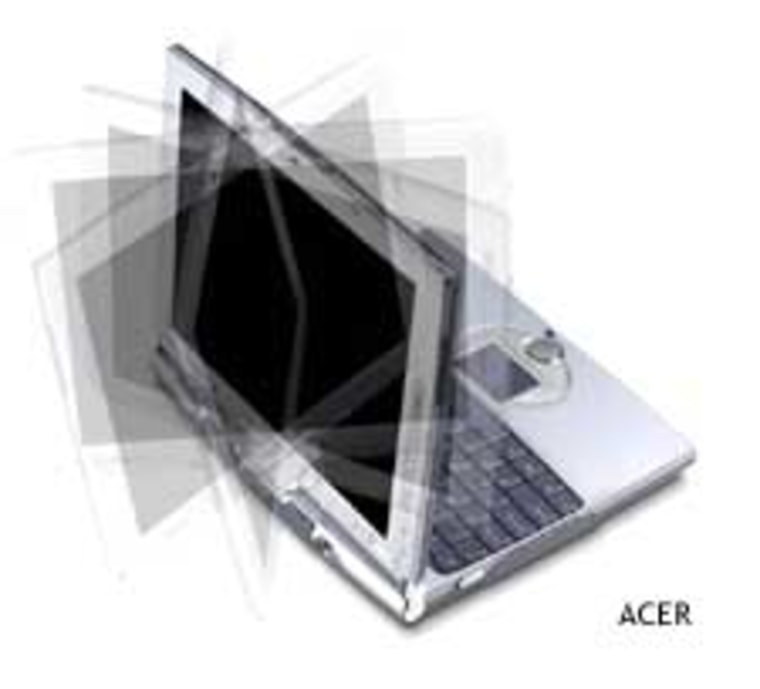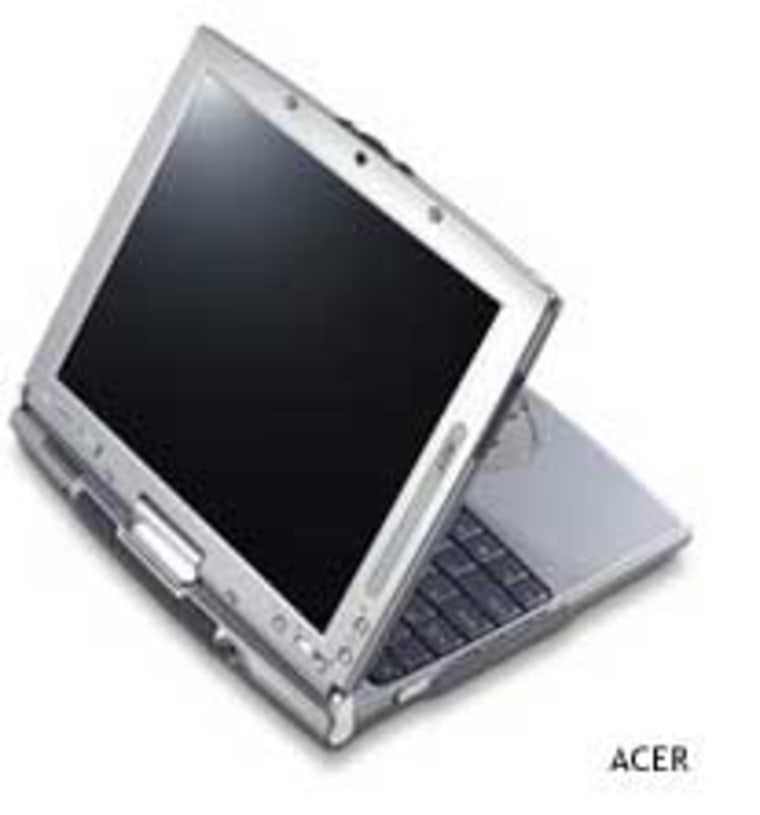I’ve reviewed a number of attempts at new Tablet computers over the past few years. They were all based on the current Microsoft operating systems at the time (Win 95, 98, NT, 2000, or CE). They weren’t really very good. They were usually heavy or awkward. I never understood the appeal. Today, in a keynote speech at TechXNY, Microsoft announces some details behind their concept of a new, useful Tablet PC.
InsertArt(1540918)MICROSOFT IS PUTTING a lot of its corporate weight behind this Tablet PC concept. It has been trying to perfect the idea for more than 10 years. I won’t go into past efforts — they’re not worth your time. But this time, Microsoft has taken its time, and got everything right, and is and finally announcing its release to the public. (MSNBC is a Microsoft - NBC joint venture.)
Microsoft gathered a number of journalists in Seattle, early this month, to instruct and enlighten us on what’s so special about a Tablet PC — and why it’s so important. Heck, even Bill Gates himself came to talk to us for nearly an hour on day two of the event.
After Gates left, Microsoft lent each publication a very, very early production Tablet PC from Acer — and gave us some very basic instruction on how to do something with it. We had to wait until the end of the gathering before we got the actual devices in our hands. I think they were afraid we’d leave if we got them early.
So, now I’ve been living with a Tablet PC for a few weeks — and I have some definite ideas about it. But I’m going to hold my thoughts until the end. First, let’s talk about what a Tablet PC is and what it can do.
Tablet PCs are actually a cross between laptops and PDAs. The devices resemble laptops and notebooks in size and allow digital pen and ink input like a PDA. Before I went to the two-day journalists seminar I couldn’t imagine what anyone would need this — but I think I’m beginning to understand.

Microsoft is making the software for Tablet PCs. This software is actually a superset of Windows XP Pro. That means it is software that sits on top of Windows XP Pro. Its main function is to provide the user with ‘Digital Ink’ — which means you write directly on the screen with a plastic stylus and your words are saved in your own handwriting. So far, so good.
Now say you need to find something in those Digital Ink notes that you saved in your own handwriting. Tablet PCs have been given the ability to search those documents and find a word of thought that you need to reference again. Finally, a Tablet PC can also take your handwriting and attempt to convert it into actual computer text. Notice I said attempt.
The first thing that all the journalists tried out when they got their machines was the handwriting recognition. Despite some friendly warnings that not everyone’s handwriting will be perfectly translated into text — even with Microsoft’s extensive library of writing samples a number of attendees instantly griped about some problems they were having. I have to admit that I had those same problems (although I was too polite to gripe in person) and found something interesting in the ensuing weeks. Even though Tablet PCs can’t be trained to better understand your scribble, when I was a tiny drop more careful and deliberate while writing the comprehension level was nearly 100 percent. It wound-up training me rather than me training it.
The big new software program inside Tablet PCs is called Windows Journal. It allows you to write and save notes in digital ink and turn handwriting recognition on and off. There are all sorts of cool things you can do to a digital ink document — including highlighting your writing, erasing, selecting, cutting and pasting plus changes color, and pen size, all with a touch of your stylus.

Digital ink can also be used in Microsoft Word and in the Outlook e-mail program. That means you can jot down an e-mail message on your Tablet and the recipient will receive it in your handwriting. If they’re on a Tablet PC they’ll be able to answer your message in their own handwriting. If they’re not using a Tablet PC they’ll see your handwriting as an image file and can answer in regular e-mail text. The first time you receive a digital ink e-mail you’ll realize how cool this really is.
In addition to digital ink, the Tablet PC is also capable of voice recognition. During the two-day event they spent about 20 minutes showing us what the Tablet can do with voice. It was pretty impressive. Unfortunately, they downplayed the Tablet’s voice recognition capabilities — I’m guessing because more people would use digital ink and because voice recognition works best when you use a headset and microphone.
The Acer itself is an interesting device. The TravelMate 100 is actually a notebook computer with a rotating, touch screen. Our test units came with a 700 MHz Pentium III mobile processor and 256 MB of memory and all sorts of ports hidden behind some very cool rubber enclosures. It is lightweight, has pretty good battery life. I preferred using the notebook in the Tablet PC mode because the keyboard keys are a little too small and closely spaced for my fingers. The Acer — like all Tablet PCs — comes with built-in 802.11b WiFi (wireless Ethernet) as standard. Like all wireless devices, expect battery life to suffer when you turn on the 2-way radio features.
Other manufacturers are planning on their own Tablet PCs too. They’ll all sport different designs. Some might look like laptops, some may have detachable keyboards, others may come with docking stations which turn Tablets into desktop devices. We’ll hear more about other designs as an actual release date nears.

Expect the first full production Tablet PCs to begin hitting the marketplace in the fall. October would be a good, educated guess. Prices have yet to be announced and all Microsoft would say is that Tablet PCs are really notebook computers with added features and capabilities and will be priced accordingly.
Microsoft envisions Tablet PCs as being exactly what business has been waiting for. From boardrooms to conference rooms, Tablet PCs could make paper-laden yellow pads a thing of the past. At least that’s what they’re hoping.
For me, I’m not quite sure if I personally need a Tablet PC. I’ll have to have one for the instant coolness factor and chance to send handwritten e-mails to friends and co-workers. But for the one time a day I use a yellow pad — and since I don’t need to archive and search what those notes, a Tablet PC may be wasted on me.
One interesting note. I was with a friend, this weekend, and didn’t bring the Tablet PC with me. My friend was saying to me that she needed to buy a new laptop but what she would really like would be a computer with the ability to add hand-written notes to the scripts and documents she receives. When I told her about the Tablet PC she agreed that’s exactly what she’s looking for. Maybe I’m wrong about the market out there.